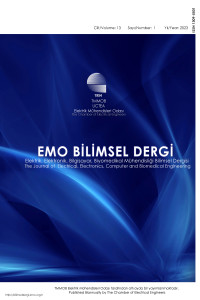Öz
Bu çalışmada yüksek DA gerilimli bir güç kaynağında kullanılmak üzere yüksek kazançlı yeni nesil bir empedans kaynaklı yükseltici çeviricinin güç katı tasarımı yapılmıştır. Ele alınan empedans kaynaklı çevirici yeni geliştirilmiş bir topoloji olup, çeviricinin temel çalışma prensibi daha önceki bir çalışmada detaylı şekilde incelenmiştir. Bu çalışmada çeviricinin hedeflenen uygulamaya yönelik tasarımı için gereken gerilim-denge ve akım-denge eşitlikleri çıkarılmıştır ve bu eşitlikler kullanılarak uygun devre elemanları değerleri belirlenmiştir. Tasarlanan çeviricinin performansı Matlab-Simulink benzetim modeli ile doğrulanmıştır.
Anahtar Kelimeler
Empedans kaynaklı çevirici Yüksek DA gerilimi güç kartı tasarımı.
Destekleyen Kurum
TÜBİTAK
Proje Numarası
121E377
Teşekkür
Bu çalışma, TÜBİTAK tarafından desteklenen 121E377 kodlu Empedans Kaynaklı DA-DA Dönüştürücülü Yüksek Gerilim DA Güç Kaynağı Tasarımı başlıklı proje kapsamında gerçekleştirilmiştir. Destek için TÜBİTAK’a teşekkür ederiz.
Kaynakça
- [1] V. Garcia, M. Rico, J. Sebastian, M. M. Hernando and J. Uceda, "An optimized DC-to-DC converter topology for high-voltage pulse-load applications," Proceedings of 1994 Power Electronics Specialist Conference - PESC'94, Taipei, Taiwan, 1994, pp. 1413-1421 vol.2, doi: 10.1109/PESC.1994.373869.
- [2] Saijun Mao, Tao Wu, Xi Lu, J. Popovic and J. A. Ferreira, "High frequency high voltage power conversion with silicon carbide power semiconductor devices," 2016 6th Electronic System-Integration Technology Conference (ESTC), Grenoble, 2016, pp. 1-5, doi: 10.1109/ESTC.2016.7764721.
- [3] Forouzesh M., ve diğerleri, “Step-up DC-DC converters: a comprehensive review of voltage-boosting techniques, topologies and applications”, IEEE Transactions on Power Electronics, 32(12), pp. 9143-9178, 2017.
- [4] Saijun Mao, Chengmin Li, Wuhua Li, J. Popovic and J. A. Ferreira, "Review of high frequency high voltage generation architectures," 2017 IEEE 3rd International Future Energy Electronics Conference and ECCE Asia (IFEEC 2017 - ECCE Asia), Kaohsiung, 2017, pp. 2260-2266, doi: 10.1109/IFEEC.2017.7992404.
- [5] Yan An Wang, Deng Ming Xiao, "Design of an Electrostatic Precipitator Power Supply Based on Transformer Stray Capacitance Effects", Electric Power Components and Systems, vol. 38, pp. 1005, 2010.
- [6] J. Liu, L. Sheng, J. Shi, Z. Zhang and X. He, "Design of High Voltage, High Power and High Frequency Transformer in LCC Resonant Converter," 2009 Twenty-Fourth Annual IEEE Applied Power Electronics Conference and Exposition, Washington, DC, 2009, pp. 1034-1038, doi: 10.1109/APEC.2009.4802790.
- [7] M. Borage, K. V. Nagesh, M. S. Bhatia and S. Tiwari, "Design of LCL-T Resonant Converter Including the Effect of Transformer Winding Capacitance," in IEEE Transactions on Industrial Electronics, vol. 56, no. 5, pp. 1420-1427, May 2009, doi: 10.1109/TIE.2009.2012417.
- [8] L. Deng, P. Wang, X. Li, H. Xiao and T. Peng, "Investigation on the Parasitic Capacitance of High Frequency and High Voltage Transformers of Multi-Section Windings," in IEEE Access, vol. 8, pp. 14065-14073, 2020, doi: 10.1109/ACCESS.2020.2966496.
- [9] D. Vinnikov, I. Roasto, “Quasi-Z-Source-Based isolated DC/DC converters for distributed power generation,” IEEE Transactions on Industrial Electronics, 58 (1), pp. 192-201, 2011.
- [10] Y. P. Siwakoti, F. Blaaberg, P. C. Loh, G. E. Town, “High-voltage boost quasi-Z-source isolated DA/DA converter,” IET Power Electronics, 7(9), pp. 2387-2395, (2014).
- [11] O. Husev, et all, “Galvanically isolated quasi-Z-source DC-DC converter with a novel ZVS and ZCS technique,” IEEE Transactions on Industrial Electronics, 62(12), pp. 7547-7556, (2015).
- [12] Y. Siwakoti, et all, “Magnetically coupled high-gain Y-source isolated DC/DC converter,” IET Power Electronics, doi: 10.1049/iet-pel.2013.0957, pp. 1-8, (2014).
- [13] X. Fang, X. Ding, S. Zhong, Y. Tian, “Improved quasi-Y-source DC-DC converter for renewable energy,” CPSS Transactions on Power Electronics and Applications, 4(2), pp. 163-170, (2019).
- [14] K. Hada, A. K. Sharma, P. S. Tomar, J. Gupta, “Modern Z-source power conversion technologies: A review,” International Research Journal of Engineering and Technology, 4(6), pp. 3207-3211, (2017).
- [15] Y. P. Siwakoti, et all, “Impedance-source networks for electric power conversion part I: A topological review,” IEEE Transactions on Power Electronics, 30(2), pp. 699-716, (2015).
- [16] M. M. Haji-Esmaeili, E. Babaei, M. Sabahi, “High step-up quasi-Z-source DC-DC converter,” IEEE Transactions on Power Electronics, 33(12), pp. 10563-10571, (2018).
- [17] M. Veerachary, P. Kumar, “Analysis and design of quasi-Z-source equivalent DC-DC boost converters,” IEEE Transactions on Industrial Electronics, 56(6), pp. 6642-6656, (2020).
- [18] F. Evran, M.T. Aydemir, “Z-source-based isolated high step-up converter,” IET Power Electronics, 6(1), pp. 117-124, (2012).
- [19] F. Evran, M.T. Aydemir, “Isolated high step-up Dc-DC converter with low voltage stress,” IEEE Power Electronics, 29(7), pp. 3591-3603, (2014).
Ayrıntılar
| Birincil Dil | Türkçe |
|---|---|
| Konular | Mühendislik |
| Bölüm | Akademik ve/veya teknolojik bilimsel makale |
| Yazarlar | |
| Proje Numarası | 121E377 |
| Yayımlanma Tarihi | 23 Ocak 2023 |
| Gönderilme Tarihi | 5 Ekim 2022 |
| Yayımlandığı Sayı | Yıl 2023 Cilt: 13 Sayı: 1 |
Kaynak Göster
EMO BİLİMSEL DERGİ
Elektrik, Elektronik, Bilgisayar, Biyomedikal, Kontrol Mühendisliği Bilimsel Hakemli Dergisi
TMMOB ELEKTRİK MÜHENDİSLERİ ODASI
IHLAMUR SOKAK NO:10 KIZILAY/ANKARA
TEL: +90 (312) 425 32 72 (PBX) - FAKS: +90 (312) 417 38 18
bilimseldergi@emo.org.tr

